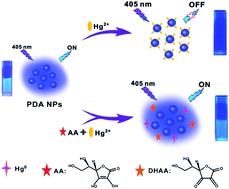Our official English website, www.x-mol.net, welcomes your
feedback! (Note: you will need to create a separate account there.)
Fluorescent polydopamine nanoparticles as a nanosensor for the sequential detection of mercury ions and L-ascorbic acid based on a coordination effect and redox reaction
RSC Advances ( IF 3.9 ) Pub Date : 2020-7-27 , DOI: 10.1039/d0ra02031a Yi-Xuan Yang 1 , Yan-Zhao Fang 1 , Jing-Xuan Tian 1 , Qiang Xiao 1 , Xiang-Juan Kong 1
RSC Advances ( IF 3.9 ) Pub Date : 2020-7-27 , DOI: 10.1039/d0ra02031a Yi-Xuan Yang 1 , Yan-Zhao Fang 1 , Jing-Xuan Tian 1 , Qiang Xiao 1 , Xiang-Juan Kong 1
Affiliation

|
Herein, a novel fluorescence nanosensor using intrinsic fluorescent polydopamine nanoparticles (PDA NPs) as an effective signal reporter has been constructed for the simple, rapid and sequential detection of mercury ions (Hg2+) and L-ascorbic acid (AA) based on a coordination effect and redox reaction. The fluorescence of the PDA NPs could be specifically quenched by Hg2+ through intense coordination effects between the Hg2+ and the groups (catechol, amine, ketone and imine) on the surface of the PDA NPs. However, when AA and Hg2+ coexisted in solution, the fluorescence of the PDA NPs pronouncedly recovered via the redox reaction of Hg2+, with it being reduced to Hg0 by AA. The fluorescence quenching mechanism of Hg2+ towards the PDA NPs and the redox reaction between Hg2+ and AA were also fully investigated. The nanosensor exhibited high sensitivity and desirable selectivity for Hg2+ and AA detection. Moreover, the strategy was successfully explored in real samples (tap water, lake water and human serum samples) with satisfactory recoveries. The developed nanosensor provides new sights and good inspiration for Hg2+ and AA detection under real conditions.
更新日期:2020-07-27































 京公网安备 11010802027423号
京公网安备 11010802027423号